
of the Art of Bleeding’s Metaphysical Medicine Show
Conducted in 2005 by Rich Polysorbate 60

of the Art of Bleeding’s Metaphysical Medicine Show
Conducted in 2005 by Rich Polysorbate 60
I came across Abram the Safety Ape and the Art of Bleeding Ambulance in a dream several years ago. An extremely vivid, life-enhancing dream that spilled from my consciousness like blood from the ear of a concussion victim.
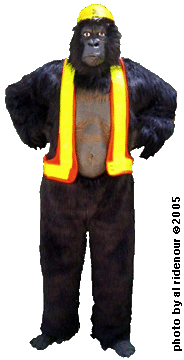 In this dream, I was walking atop a giant black pipe that overhung a steep cliff. I was young -- around the age of seven. I began to lose balance and fell into a wobbling movement that some how led to my being sucked up into this pipe and....blackness.
In this dream, I was walking atop a giant black pipe that overhung a steep cliff. I was young -- around the age of seven. I began to lose balance and fell into a wobbling movement that some how led to my being sucked up into this pipe and....blackness.
Still in that dream, I then awoke in an ambulance, a cherry-scented ambulance dripping a sort of pinkish strawberry goo from its innards. It was as if this ambulance were alive, had digested me, and now I was a living part of its mind and digestive tract.
Around me were raccoons on surgical trays to my side. They were frantically moving their arms around as if to tell me something before I blacked out again. But they never did, and I again lost consciousness.
When I came to, I was in another place -- waiting in a room that seemed like a cross between a sand-box made of rubber tires and a urine-stained doctor’s office with caustic green walls and a crowd of noisy patients. When I had waited long enough, I got up and went to a sliding window. The frosted pane snapped back, and there was the glaring face of spider monkey. A staring contest began. I could not flinch or look away, was rooted to the spot, perhaps hypnotized. Its glaring eyes bore into me like little black drills, and as the blackness came, I realized that my skin was, in fact, filled with bleeding holes.
Several years later, I went to this Art of Bleeding demonstration outside of the ArcLight Cinema near the corner of Hollywood and Vine. The others watching seemed confused and a bit defensive about what they were witnessing. But I experienced something different, an icy déjà vu… and the feeling that I knew... I just knew. The videos, the ambulance, the Busby Berkeley blood-nurses, and Abram the Safety Ape-- always asking questions, full of tricks, and trauma, and yet somehow pointing the way toward enlightenment. The whole damn thing made sense, and I did something that I have not done in years -- I cried. I cried and experienced something like gnosis. I couldn’t avoid it. It just hit me like a car plowing into a pedestrian who’d ignored the signals.
That ambulance light shone on me, and I felt sucked into it, just as I was sucked into that little black pipe in my prophetic dream. I am now a participant or rather a channeled helper to the ambulance and Abram is a conduit to something I can't intellectually explain or shelf.
Months have passed as I have pieced together these experiences. I tried to formulate the questions which might help me understand. Finally, I went to visit Abram at the Art of Bleeding compound in the Mojave ranchlands beyond Yucca Valley. This is a part of our exchange.
POLYSORBATE: Where were you before the call to safety awareness?
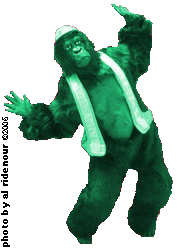 ABRAM: Actually, I grew up within the very bosom of safety awareness, or True Safety Consciousness (TSC), as we call it. I suppose I am very privileged in that way. I never really knew my biological parents as they were killed by poachers when I was newborn. I was rescued from the bushmeat market by the radical Austrian psychologist Dr. Abram S. Lugner in 1978 while he was touring Rwanda. Dr. Lugner actually suckled me at his breast! Of course, I was also bottle-fed at the time, but his belief in the psychological importance of the nursing experience was strong enough that he was willing to enough to endure the unkind comments of the hotel staff and other natives. He was a great man and a true visionary, and I am proud to bear his name. My rescue happened to coincide with his efforts to create a theatrical mode of communicating the principles of True Safety Consciousness through the Art Of Bleeding Foundation.
ABRAM: Actually, I grew up within the very bosom of safety awareness, or True Safety Consciousness (TSC), as we call it. I suppose I am very privileged in that way. I never really knew my biological parents as they were killed by poachers when I was newborn. I was rescued from the bushmeat market by the radical Austrian psychologist Dr. Abram S. Lugner in 1978 while he was touring Rwanda. Dr. Lugner actually suckled me at his breast! Of course, I was also bottle-fed at the time, but his belief in the psychological importance of the nursing experience was strong enough that he was willing to enough to endure the unkind comments of the hotel staff and other natives. He was a great man and a true visionary, and I am proud to bear his name. My rescue happened to coincide with his efforts to create a theatrical mode of communicating the principles of True Safety Consciousness through the Art Of Bleeding Foundation.
POLYSORBATE: What is the true significance of the ambulance? Exactly who really drives it? Is the patient reborn?
ABRAM: What we call the "magic ambulance" is in fact the "sweet chariot" of the gospel hymn. It "swings low" brushing the critically injured with a divine wisdom not accessible to normal consciousness. Though I’ve been given the keys to the ambulance and am technically the driver, I know nothing of the ride. The patient experiences that, taking one of two roads, the lower returning to an earthly existence enlightened by True Safety Consciousness, or the higher returning to the eternal.
POLYSORBATE: What does the logo represent? The five directions? The center?
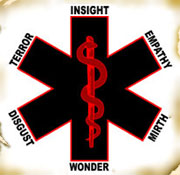 ABRAM: It is patterned after the so-called "Star of Life," used on ambulances throughout the country, however its meaning is substantially different. The five lower points of the Art of Bleeding Star each represent a different emotionally charged state of mind: "empathy," "mirth," "wonder," "repulsion," and "terror." In order to dramatically impress the principles of True Safety Consciousness, we strive to induce these states within the audience. The sixth point of the star, its uppermost and central point, "insight" represents the summation of perceptions acquired in the other five states. The central snake emblem is a traditional Gnostic symbol for the attainment of insight.
ABRAM: It is patterned after the so-called "Star of Life," used on ambulances throughout the country, however its meaning is substantially different. The five lower points of the Art of Bleeding Star each represent a different emotionally charged state of mind: "empathy," "mirth," "wonder," "repulsion," and "terror." In order to dramatically impress the principles of True Safety Consciousness, we strive to induce these states within the audience. The sixth point of the star, its uppermost and central point, "insight" represents the summation of perceptions acquired in the other five states. The central snake emblem is a traditional Gnostic symbol for the attainment of insight.
POLYSORBATE: Why do the nurses wear latex nurse uniforms instead of cloth? Are they especially trained for the Art Of Bleeding?
ABRAM: Dr. Lugner believed that skimpy or tight-fitting latex and vinyl uniforms would help focus audience attention in ways that modest cloth uniforms cannot. There is also the practical matter of waterproof surfaces being more resistant to various liquids that often fly about in these shows. Training for our nurses is similar to that of other Art Of Bleeding staff members, and consists of workshops in phantasmagoric education, strict mind-body regimens, staged accidents, sensory immersions and a forty-day period of isolation.
POLYSORBATE: Some have described the Art Of Bleeding as a modern medicine show, how do you feel about this? Is this accurate in any way?
ABRAM: Well, the big difference there is that the Art Of Bleeding isn't selling any cure-all. Unlike the Red Cross, for instance, we do not fixate on "quick fixes" like CPR because we believe these tend to overshadow the deeper significance of the accident itself. But there may be something to the comparison in terms of the sort of freewheeling theatricality we associate with the old-time medicine show. And our performances have also have elements of the circus or vaudeville, and these are certainly cousins to the medicine show.
POLYSORBATE: What message do you hope to convey that might be lacking in the presentations of the standard health and safety presentations?
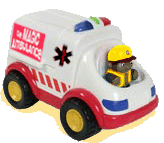 ABRAM: I believe we provide deeper insight into the truly paradoxical nature of accidents and injury. With traditional safety programs the bottom line is simply avoiding accidents and medical emergencies, but we believe this stops short of the real problem -- that of a mind not yet awakened to True Safety Consciousness. Accidents themselves are not the problem. In fact, accidents can have a transformative positive aspect. The notion of the accident as a form of breakthrough is key to our teachings. When we speak of the "Art of Bleeding," we are using in paramedical symbols to speak of this change of consciousness. Bleeding occurs when we break through the boundaries of our physical bodies, so it serves as our Foundation's shorthand for "breakthrough."
ABRAM: I believe we provide deeper insight into the truly paradoxical nature of accidents and injury. With traditional safety programs the bottom line is simply avoiding accidents and medical emergencies, but we believe this stops short of the real problem -- that of a mind not yet awakened to True Safety Consciousness. Accidents themselves are not the problem. In fact, accidents can have a transformative positive aspect. The notion of the accident as a form of breakthrough is key to our teachings. When we speak of the "Art of Bleeding," we are using in paramedical symbols to speak of this change of consciousness. Bleeding occurs when we break through the boundaries of our physical bodies, so it serves as our Foundation's shorthand for "breakthrough."
POLYSORBATE: Can work stress in the medical field produce mystical insight, in the same way injury to a patient can?
ABRAM: Absolutely. The stress is enormous. Gunshot wounds, stabbings, bodies burned beyond recognition. Of course, as a Safety Mascot, I don't deal with these problems directly, but I'm constantly exposed to questions about these sorts of things from class after class of noisy uncooperative schoolchildren. All of them squirming and talking and tugging on my vest, and talking during the slideshows. Sometimes I will just stop talking and stand there like a test to see what will happen next, and I'll stare out and see those incessantly running mouths and bodies all spastic from their breakfast sugar-rush, and the noise will just go on and on and on and on and get louder and louder. But if I let it go like that. If I really just let it get as loud as it wants and don't try to fight it, it will happen – there will be that popping sound in the back of my head, like a speaker just broke, and then I’ll see all the mouths and 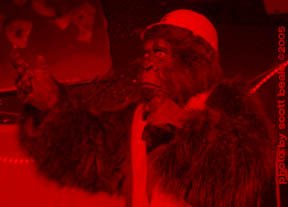 commotion still going, but it will be like a movie without sound. And then I will feel the cool white fog. I am the center of the fog, and it just rolls out from the center, blanketing row after row of desks and students who suddenly grow still and quite and then just go away. But it's never complete. I never let it finish because I am afraid to see the fog roll through that back wall of the room. I just have to close my eyes because of the feeling that if those walls go, there will be nothing but fog everywhere, an entire universe of fog with no top or bottom, and I feel like I will fall forever if I let that happen. Usually by that point, I will open my eyes and find I am back in the ambulance and someone else has taken the keys and is driving me home. I only have to work a few hours on days like those.
commotion still going, but it will be like a movie without sound. And then I will feel the cool white fog. I am the center of the fog, and it just rolls out from the center, blanketing row after row of desks and students who suddenly grow still and quite and then just go away. But it's never complete. I never let it finish because I am afraid to see the fog roll through that back wall of the room. I just have to close my eyes because of the feeling that if those walls go, there will be nothing but fog everywhere, an entire universe of fog with no top or bottom, and I feel like I will fall forever if I let that happen. Usually by that point, I will open my eyes and find I am back in the ambulance and someone else has taken the keys and is driving me home. I only have to work a few hours on days like those.
POLYSORBATE: Can you talk about some of the peripheral characters?
ABRAM: Yes. "Peripheral" is, of course, the key word here since I am the Foundation's official representative. However, many of our shows now also include appearances by RT the Robot Teacher, whose soulless grasp of dry colorless facts and data provides the raw material for my warm and engaging left-brain-oriented commentary. We also occasionally feature appearances from consulting physician and amateur occultist Dr. J. Elmer Moody who is a hand-puppet, and Faceless, the Boy Who Learned Too Late. Faceless is a 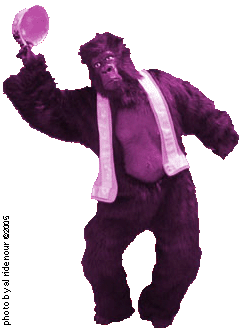 mysterious but lovable man-child who suffered an accident in his youth, which resulted in him now appearing in public with his face and head entirely concealed under gauze bandages. He communicates through a puppet called Fergus the Firedog.
mysterious but lovable man-child who suffered an accident in his youth, which resulted in him now appearing in public with his face and head entirely concealed under gauze bandages. He communicates through a puppet called Fergus the Firedog.
POLYSORBATE: Did you like Bringing Out the Dead? Do you believe that the main character was generally good? Have you had similar experiences?
ABRAM: Is that a television show? We do not have television at the ranch out in Yucca Valley because Dr. Lugner believed that television is a corrupting influence. The only film or video we see are source materials for Art of Bleeding sensory bombardment experiments and those tend to be health-and-safety films produced in the 1970s or ‘80s.
POLYSORBATE: Will you ever bring the Art Of Bleeding to a large hospital like Kaiser or UCLA?
ABRAM: We haven't approached UCLA yet, but we did apply to Kaiser Healthcare to be part of their "Festival of Wellness." Unfortunately they wrote back saying that our performance proposal was "of questionable educational merit and potentially hazardous." They also complained because they said that in the photos we submitted RT the Robot Teacher's utility hose looked like a penis. It's kind of sad, really, but perhaps once Dr. Lugner's works are finally translated into English, there will be greater openness to our unconventional modes of presentation.
POLYSORBATE: We can only hope!
For more information on the Art Of Bleeding Foundation, upcoming presentations, and ongoing mission, please visit them online at www.artofbleeding.com.
(Rich Polysorbate 60 is a contributing writer to No-Fi "Magazine" and a longtme member of The Cacaphony Society)
THE END

